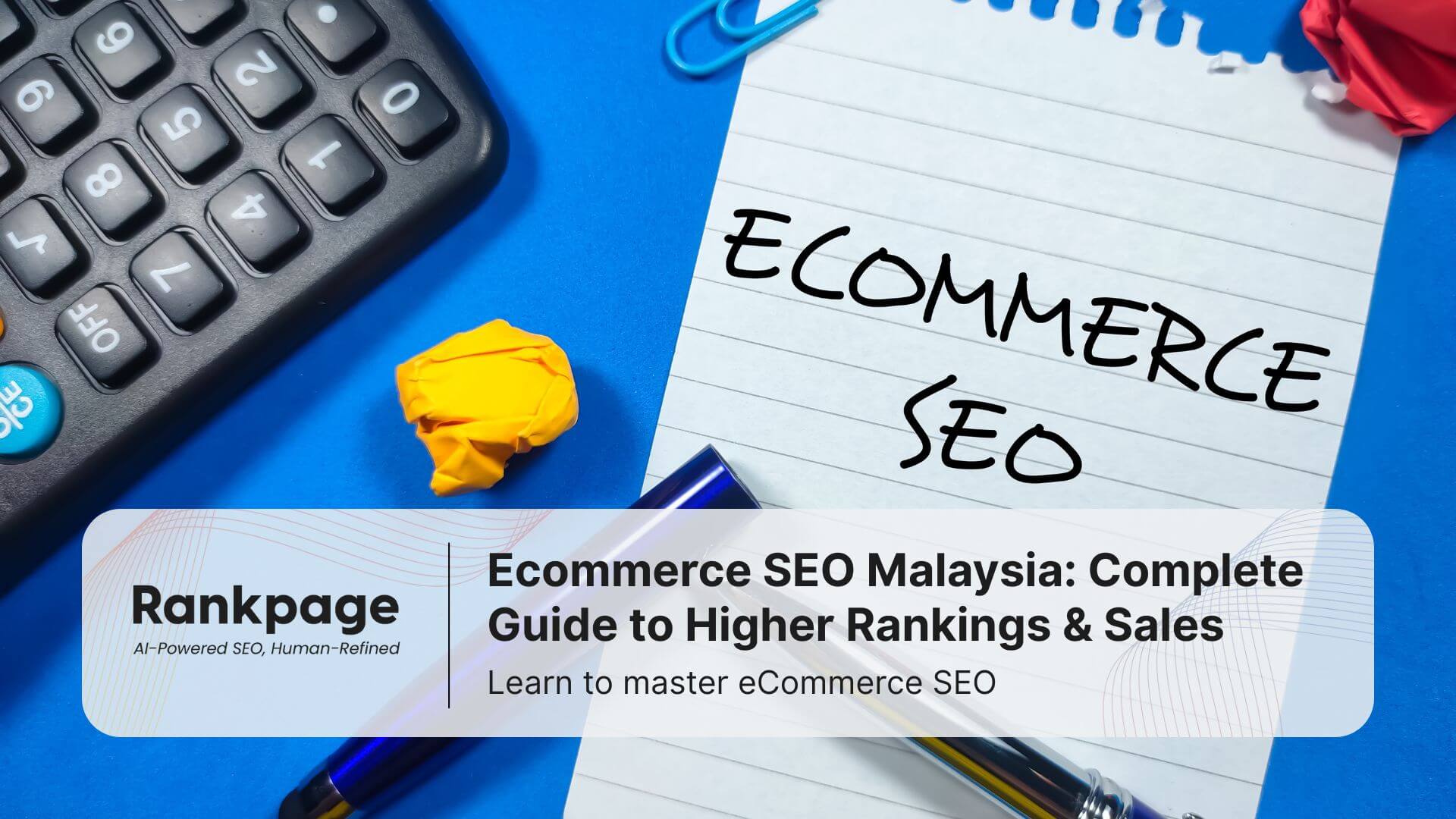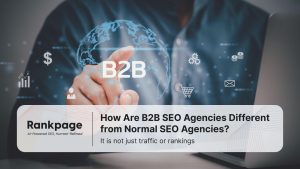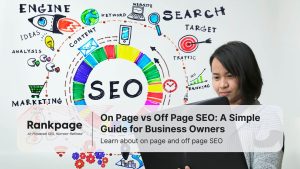Key Takeaways
- Ecommerce SEO in Malaysia starts with data-driven keyword research and bilingual search intent, not guesswork.
- On-page optimisation includes schema, Core Web Vitals, and structured product pages designed for Google and AI Overviews.
- Content must target buyer journeys from category pages to blogs while balancing Malay and English search behaviours.
- Strategic link building uses trusted local sources, directories, and media mentions, not spammy backlinks.
- Success is measured by rankings, traffic, and conversion lift, not vanity metrics.
Ecommerce SEO in Malaysia is the process of optimising online stores to rank higher on Google and AI-driven search. It combines keyword research, technical fixes, and content strategies tailored to bilingual shoppers, helping businesses increase visibility, traffic, and conversions in 2025.
Many online stores here still struggle with slow sites, weak product descriptions, and poor mobile experience, issues that directly cost sales in Malaysia’s competitive eCommerce market.
This guide explains every step of ecommerce SEO, from keywords to conversions, with Malaysia-specific tactics you won’t find in generic global blogs.
Table of Contents
What Is Ecommerce SEO in Malaysia?
Ecommerce SEO helps online stores rank higher and attract buyers.
At its core, it means structuring your online shop so search engines understand your products and users find what they need quickly. Unlike paid ads, ecommerce SEO generates lasting visibility without relying on ongoing advertising budgets.
Why Is Ecommerce SEO Important in 2025?
SEO boosts long-term sales growth without constant ad spending.
In Malaysia, digital advertising costs rise each year. This is true in competitive areas like fashion and electronics, where Cost Per Clicks (CPCs) keep climbing. At the same time, online shopping is booming. More consumers are using ecommerce platforms for their daily needs.
In this situation, SEO provides lasting value. Once your site ranks well, you can draw steady traffic and sales without raising your marketing budget.
“Investing in SEO now is like building a digital asset that pays dividends long after campaigns end.” — Senior SEO Analyst, Rankpage
How Does Ecommerce SEO Work?
To rank well and drive traffic that converts, ecommerce SEO focuses on five key pillars which are keywords, on-page setup, content, backlinks, and analytics. Each part works together to improve your store’s visibility and sales over time.
Keyword Research
This is where it starts. Find the exact words shoppers type into Google when looking for your products. For Malaysia, that means understanding both English and Bahasa Malaysia search habits. Tools like Google Keyword Planner, Ahrefs, and even checking what Google auto-suggests can help uncover terms like “cheap smart TV Malaysia” or “baju kurung murah online.”
On-Page SEO
Once you know your keywords, make sure your website reflects them. Optimise your product, category pages, and URLs. Adding schema markup helps Google understand details like price, availability, and reviews so they can show up directly in search results.
How to Optimise Product & Category Pages:
Element | Optimisation Tip | Example |
Product Titles | Use clear, keyword-rich titles with product details. | “Waterproof Hiking Backpack Malaysia, 40L, Lightweight” vs “Backpack” |
Meta Descriptions | Highlight benefits, urgency, or offers. | “Free shipping, limited stock available – order now.” |
Schema Markup | Add product schema for price, stock, and reviews. | Rich snippets showing “RM199 – In Stock – ★★★★★ 120 reviews” |
Product Descriptions | Write unique, benefit-driven content. | “Perfect for weekend hikers, fits laptops and camping gear, lightweight build.” |
Images & ALT Text | Use multiple high-resolution images, add descriptive ALT text. | Image name: leather-wallet-brown.jpg / ALT: “genuine leather wallet for men” |
Mobile UX | Optimise for speed, scrolling, and clear CTAs. | Buttons: Add to Cart / WhatsApp Enquiry |
Category Pages | Add buying guides, comparisons, or tips. | “How to choose the right size hiking backpack for your trip.” |
Tip: Think of each product page as both a salesperson and a search magnet. The stronger you optimise both sides, the higher your traffic and conversions.
Content Strategy
Content is essential for capturing search intent, building trust, and guiding users through the buying journey.
Examples: “Best wireless earbuds under RM200” or “Skincare routine for oily skin in Malaysia weather.” These draw in traffic and build authority.
Read more: What Is the Role of Content in Ecommerce SEO?
Link Building
Links from other websites tell Google your store is trustworthy. Focus on getting featured in local influencers’ profiles, news sites, adding your store to business directories, or collaborating with niche bloggers. Also, avoid shady tactics like buying low-quality links. Google can penalise you for it.
Analytics
Don’t guess, track. Use tools like Google Analytics 4 (GA4) and Google Search Console. These help you monitor traffic, conversions, and the keywords that drive sales. It’s not just about clicks, it’s about what brings in real revenue.
How Can Local SEO Boost Ecommerce Visibility?
Local SEO isn’t just for physical shops, it’s crucial for ecommerce businesses offering local delivery, in-store pickup, or hybrid fulfilment. It helps you show up when nearby customers search for products you sell.
Google Business Profile
Set up or update your Google Business Profile (formerly Google My Business). Add clear details like your operating hours, pickup and delivery options, service areas, and contact info. This helps you appear in local map results and Google’s “near me” searches.
Local Directories & NAP Consistency
List your business in local directories (such as MyCen, Yellow Pages, and more) and make sure your NAP (Name, Address, Phone number) is consistent across all platforms. Google uses this info to verify your business legitimacy and improve your local ranking.
Customer Reviews
Encourage satisfied customers to leave reviews on Google and other local platforms. Reviews influence how your business ranks and whether shoppers trust you. A high rating with real feedback can directly impact clicks and conversions.
Why It Matters for Ecommerce
Even if you operate mainly online, local SEO helps you attract high-intent buyers in your area. It builds visibility in searches like “buy air fryer KL” or “online florist Penang with same-day delivery,” helping you win more local orders.
How Do You Measure Ecommerce SEO Success?
Real SEO success is measured by how well it brings the right visitors and turns them into customers
- Organic Traffic:
Look at how many visitors are coming from unpaid (organic) search. If traffic is growing month-on-month, it means your SEO is working.
- Conversions:
Traffic is good, but sales are better. Use tools like Google Analytics 4 (GA4) to see how many purchases come directly from search traffic.
- AI Visibility (SGE & Snippets):
Check if your pages appear in Google’s AI-generated answers (AI Overviews) or featured snippets. These are prime spots that drive high click-through rates without needing ads.
- Engagement Metrics:
- Dwell Time: Are users staying and browsing?
- Click-Through Rate (CTR): Are people clicking your search result?
- Bounce Rate: Are they leaving immediately or exploring your site?
These indicators show your store’s visibility and how well it convinces people to buy.
What Mistakes Should Ecommerce Sites Avoid?
Even small SEO mistakes can hurt your traffic, rankings, and conversions. Here are the most common issues and how to fix them fast:
Slow Website Speed
A slow-loading site frustrates users and gets penalised by Google. Causes include poor hosting, large image files, or unnecessary scripts. Use tools like PageSpeed Insights to check and fix issues.
Duplicate Content
Copying product descriptions from suppliers or other sites can harm your rankings. Google prefers original, helpful content. Always rewrite descriptions to reflect your brand and speak directly to your audience.
Thin Product Pages
Pages with just one or two lines of text often don’t rank. Add more detail in benefits, sizing, FAQs, and use cases to help both Google and shoppers.
Missing Schema Markup
Without structured data (like Product schema), Google can’t show your prices, ratings, or stock in search results. This limits visibility and click-through rates. Schema is a simple fix with big returns.
Ignoring Mobile Optimisation
Most ecommerce browsing happens on phones. If your site isn’t mobile-friendly which is slow, hard to tap, or poorly laid out, you’ll lose both rankings and customers.
Fixing these errors often brings quick wins in traffic, engagement, and sales without needing more content or backlinks.
Conclusion: Right Ecommerce SEO Partner Turn Searches Into Sales
Ecommerce SEO in Malaysia isn’t about chasing algorithms, it’s about aligning your store with how Malaysians actually search, compare, and shop online. From bilingual keyword targeting to schema-enhanced product pages, each optimisation step helps build visibility, trust, and conversions over time.
With ad costs rising and AI-driven search reshaping how people find products, the right SEO strategy is no longer optional, it’s essential.
But success depends on the right agency partner. Avoid providers that promise “#1 rankings,” offer suspiciously low prices, or can’t show transparent reporting. Instead, ask:
- Can you share recent case studies with local brands?
- What tools and metrics do you use to track results?
- How do you adapt to AI search and changing algorithms?
Rankpage delivers tailored ecommerce SEO strategies built for Malaysia’s unique market, focusing on sustainable growth, measurable ROI, and real search visibility.
In 2025, the brands that invest in SEO won’t just rank better, they’ll sell better. Will your store be one of them?
Disclaimer: This content is for general informational purposes only and does not constitute business, marketing, or legal advice. SEO strategies and search engine algorithms evolve frequently. Always consult a qualified digital marketing professional or SEO expert familiar with Malaysia’s market before making decisions.
Frequently Asked Questions About Ecommerce SEO in Malaysia
What is ecommerce SEO in Malaysia?
Ecommerce SEO in Malaysia is the process of optimising online stores with keywords, technical fixes, and content to rank higher on Google and AI-driven search.
How long does ecommerce SEO take to show results?
Most online stores in Malaysia see noticeable SEO improvements within 3–6 months, depending on competition, website health, and consistent optimisation efforts.
Do I need bilingual keywords for ecommerce SEO in Malaysia?
Yes. Targeting both English and Malay keywords captures wider search intent, helping ecommerce stores reach more local buyers and improve overall visibility.
How is ecommerce SEO different from paid ads?
SEO builds long-term traffic and credibility, while ads stop once budgets end. Most successful ecommerce stores use both for balanced growth in Malaysia.
What are the biggest ecommerce SEO mistakes?
Common mistakes include duplicate product content, ignoring Core Web Vitals, thin descriptions, slow mobile sites, and neglecting schema markup or local search optimisation.
Should I hire an ecommerce SEO agency in Malaysia?
Hiring an agency helps save time, avoid costly mistakes, and apply proven strategies with measurable ROI, especially for competitive ecommerce niches in Malaysia.





